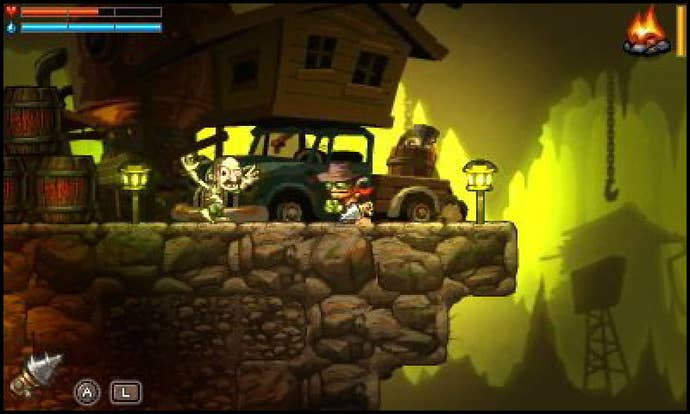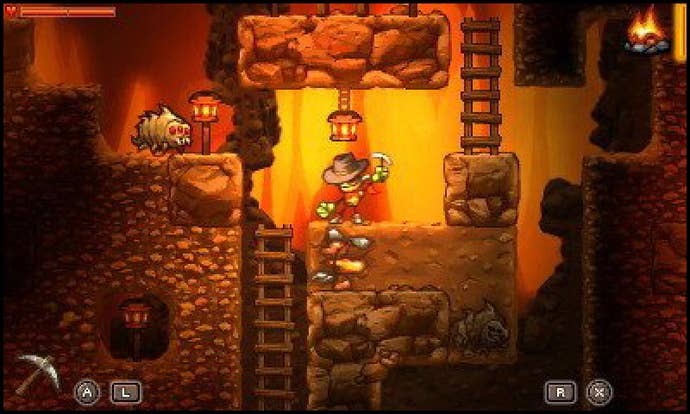SteamWorld Dig Review
Like the dinosaurs of Jurassic Park, this eShop action game recombines ancient DNA to create something completely cool.
This article first appeared on USgamer, a partner publication of VG247. Some content, such as this article, has been migrated to VG247 for posterity after USgamer's closure - but it has not been edited or further vetted by the VG247 team.
There's nothing I like better than a video game bursting with incredible new ideas realized to perfection. But that's a tall order, and failing that I'll happily settle for lots of old ideas combined in an interesting way. Image & Form's new 3DS eShop release SteamWorld Dig offers precisely that.
I could easily describe Dig in terms of other games, but not in a dismissive or critical sense. Like a lot of indie developers, Image & Form have clearly drawn influence from the greats here, but they've done so with a sort of freshness and purity of design that you don't get from big-budget retail software. Besides, many of the great artists of our times got their start by copying the old masters.
So yes, you'll definitely get Metroid vibes from Dig, something that's true of just about every indie platformer these days. A short distance into the adventure you'll acquire a speed booster that works just like the one in Super Metroid, all the way down to the fact that the only way to get out of the room where the power-up is located is to dash across blocks that crumble as you pass over them. Later, you'll acquire the ability to leap in midair (discharging electricity that destroys monsters in the process) and perform wall jumps, too. The ghost of Samus Aran is never far behind protagonist Rusty, like a metaphorical version of the ghost from Spelunker (which Dig resembles more than a little).

But you'll also be put in mind of Namco's Dig Dug and Mr. Driller games, too. Rusty descends into the earth a meter a time, digging through increasingly tough layers of rock and dirt in search of treasure and a mysterious legacy left to him by his uncle. Your digging efforts carry over persistently throughout the game -- once you break a rock, it's gone for good. Rooting beneath unbreakable stones will dislodge them, causing them to come crashing down on top of whatever happens to be below them.
And, as in Mr. Driller, you're constantly racing against dwindling resources as you descend. Your solar-powered light source quickly depletes while you dig, reducing your visibility little by little until it ultimately runs out and renders you unable to make out any details beyond the silhouette of the mine shafts you've created. The second vanishing resource, water, powers your pneumatic tools (your drill, jump boots, etc.) and can be refilled in any underground reservoirs you happen to find. After all, this is a "SteamWorld" game; while the steampunk concept tends to be overplayed and overly trite, Dig makes really clever use of it by turning water into a logical means for recharging your resources while on the move.

What Dig resembles most, however, is a dungeon-crawler RPG. Not a roguelike -- despite the fact that contemporary indie devs are as drawn to that particular subgenre as they are to Metroid -- but rather the classical form a la Wizardry, Diablo, or Etrian Odyssey. You can only delve so far into the underground in each trip, limited by your tools, your resources, and your capacity for hauling loot. Each foray takes you a little further than the last, and with each outing you come back with enough earnings to buy upgrades to make your skills just a little better than they were before, thus further increasing your exploratory range. It creates an addictive push-pull dynamic that drove me to finish the game across two sessions in less than a day, always struggling to find that perfect balance of heading back to cut my losses or risking everything to grab just one more piece of loot.
Not that you lose everything when you die. There's a little bit of Dark Souls going on here, too. Die in the dungeon and you lose half your cash on hand, while the loot you've collected to resell drops where you died. You can venture downward and reclaim it at equal peril, but you can't take too long; eventually (either if you spend too much time reaching it or die too many times -- the mechanic wasn't entire clear to me) that loot vanishes, lost forever.
I don't want to spoil too much of the experience, brief as it is, but SteamWorld Dig works wonderfully. It has a very specific focus -- digging and character improvement for the sake of more effective digging -- and never strays far from it. Various monsters do exist underground, and there are plenty of hazards to avoid, but Dig never focuses on combat... even in the final battle, as it were, which has a hint of Portal about it. Ah, but there I go again, spoiling things.
Jaz Rignall, Editorial Director
This delightful little platformer draws its inspiration from some of my favorite old games. Although it doesn’t play like them, its digging mechanics reminded of classics like Mr Do, Boulderdash and Dig Dug. Yet while it does blaze a well-worn trail forged decades ago by its forebears, SteamWorld Dig still feels fresh thanks to its contemporary details. It’s very nicely designed, looks gorgeous and – something I really enjoyed – it plays a strange kind of brinksmanship with you. I’m a sucker for this kind of stuff. Do I stick around and risk everything for that last bit of loot, or do I play it safe and come back later?
Of course, I kept risking things and being annoyed with myself for being a greedy ass when I paid the ultimate price. But, like a great game should, that annoyance immediately got funneled back into doing it better next time, rather than turning the 3DS off in frustration. And that’s a ringing endorsement right there.
SteamWorld Dig isn’t the biggest game in the world, and I’m plowing through it apace. But considering it weighs in at the bargainsville price of just a penny short of $9, it’s well worth buying. And frankly, sometimes it’s nice to get a game you know you can finish and feel like you’ve got your money’s worth, rather than feeling obligated to squeeze the value out of it.
Lovely game. Very addictive. Super fun. Pretty much defines what I love about 3DS gaming. Get!
The Details
- Visuals: While it could come off as some kind of cheap Flash game, Dig's graphics make great use of color and shadow not only to lend visual impact, but also as a key gameplay mechanic.
- Audio: Dig's one weak point; the music shoots for atmospheric but lands short as a dull drone. Sound effects, on the other hand, tend to be grating and harsh.
- Interface: I'm not in love with some of the button mapping choices, but there's nothing offensive here. And I appreciate a 3DS game that's content to avoid 3D and touch-screen gimmickry altogether.
- Lasting Appeal: Short and simple; my near-complete first run took me about seven hours. I could definitely go for more, but at the same time this particular game feels complete as-is... and the secret ranking system revealed at the end just begs for speedrunning.
ConclusionSuffice it to say this is exactly the kind of game eShop needs more of: Simple, addictive, and creative despite wearing its influences prominently. Highly recommended.








